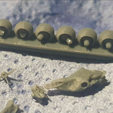3D model description
Why test gaps? Gaps show how detailed your resin printer can print without blooming blurring details, so this can be used to compare resins, printers, and settings both for accuracy and the ability to print close parts like my mini mail, but also detail in general.
By having an inner and outer sphere with gaps varying from 150um going up to 300um in 25um steps, this test print shows you how big of a gap your printer can maintain in the most demanding situation- gaps with lots of surface area across all angles. You can get smaller gaps with other shapes like say two close cones or spheres side by side, but this on the other hand is the worst-case scenario of gaps, so if you can get a specific gap with this you can get it anywhere such as my mini mail which should work without rings joining if you have 250um gaps
If you have something far superior to me like a Saturn 2 or DLP printer and manage to get to the lowest rating let me know and I'll make it lower.
3D printing settings
You can print this to compare exposure times, as in printing lower exposures and seeing how much better your gaps get. However, it's best used by first finding the correct exposure with a strength test like The Cones of Calibration, and then seeing what gaps you can get at this. This way you can compare resins to find which resin gets you the smallest gaps while being strong. You can also use this to test, layer heights, and other print settings like AA or wait-time, etc, or even different printers. I think this would be one of the best, most objective tests to show what printer has the least blooming and most detail.
I'd recommend printing across the bed to test the whole screen, my printer for example exposes in the middle, and while I never noticed it in normal prints this show is perfectly.
Once printed, and cleaned, but before curing (to avoid leftover resin in the gaps welding them) try to push up the nobs with your nail (using gloves of course) or a tool. If the gap was maintained you should be able to move the ball inside the socket, if not the nob will just break off.
Now what gaps are you really getting?? if say you get down to 200um as I did using 25um layer heights with my 50um resolution printer, are you actually getting a 200um gap?? Well no, that's just the model, due to expansion it's naturally much lower hence why at some point there is no gap when there should be. So by feeling the play in the sockets, you could also use this to test if the actual gaps you get are smaller at a normal exposure or by underexposing, of course, the number you get down to will be lower if you underexpose and that will mean you can print in more detail, but is the gap actually smaller? You can find out that by feeling the play, but this isn't objective like the test is otherwise so I might make another tester to find actual minimum gaps which would be useful for making something like ball socket joints printed in place. When making my mini mail I wasn't sure if it was better to make the mail smaller or under-expose to get the rings smaller so they wouldn't stick this is the type of information I am talking about here.

/https://fbi.cults3d.com/uploaders/27757239/illustration-file/845762b9-59bf-4a4c-8bb4-0ec97f3bddf2/Screenshot-2023-05-19-220202.png)






